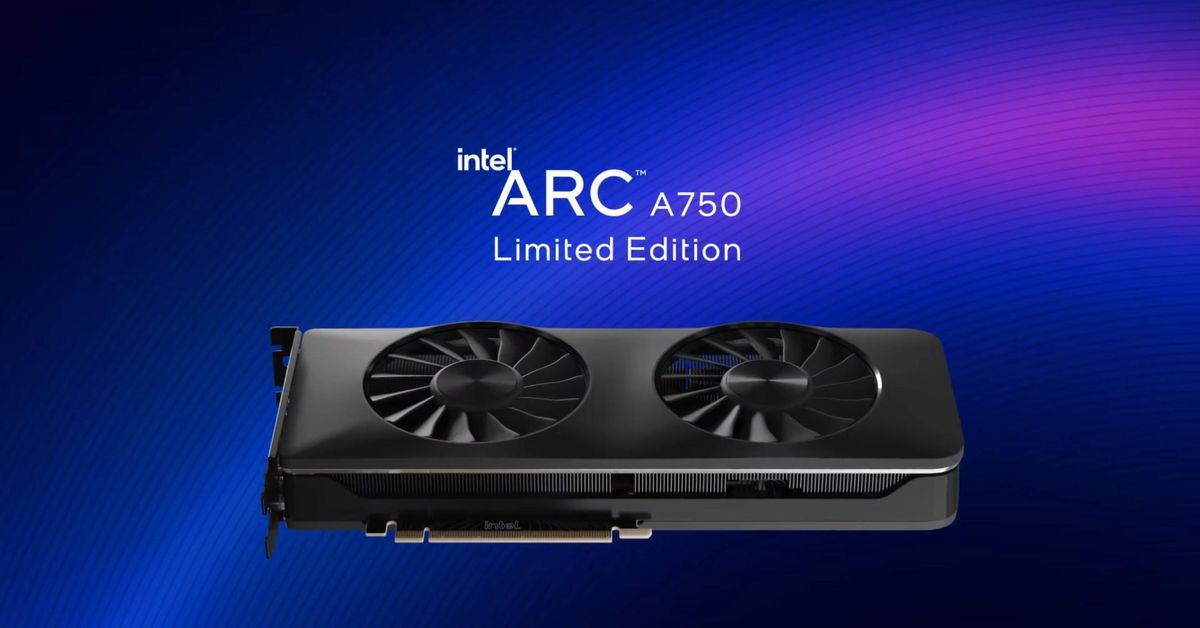Intel has released 48 benchmarks that show its upcoming Arc A750 GPU should be able to trade blows with Nvidia’s RTX 3060 running modern games. While Intel set its expectations low for its Arc GPUs last month, the company has now tested its A750 directly against the RTX 3060 across 42 DirectX 12 titles and six Vulkan games.
The results look promising for what will likely be Intel’s mainstream GPUs later this year. Intel has tested the A750 against popular games like Fortnite, Controland Call of Duty: Warzoneinstead of the cherry picked handful of benchmarks the company released last month.
“These are all titles that we picked because they’re popular,” explains Intel fellow Tom Petersen, in Intel’s benchmark video. “Either reviewers are using them or they’re high on the Steam survey, or new and exciting. These are not cherry picked titles.”
:no_upscale()/cdn.vox-cdn.com/uploads/chorus_asset/file/23937581/nlV6Ppv.jpeg)
We’ll have to wait for independent benchmarks, but based on Intel’s testing, the A750 looks like it will compete comfortably with Nvidia’s RTX 3060. “You’ll see we’re kinda trading blows with the RTX 3060,” says Petersen. “Sometimes we win, sometimes we lose.” Intel’s performance is, on average, 3 to 5 percent better than Nvidia’s when it wins on titles running at 1080p.
Over on the 1440p side, it looks like Intel wins on more of the benchmarks. On average it’s a win of about 5 percent across the 42 games. Intel has also tested six Vulkan titles, where it seems to be trading blows with the RTX 3060 once again.
“We’re mostly winning at 1080p, and mostly winning at 1440p with Vulkan,” Petersen claims. “On average I’d say this is more like a 3 to 5 percent, maybe a little bit more towards the 5 percent win on Vulkan.”
:no_upscale()/cdn.vox-cdn.com/uploads/chorus_asset/file/23937582/BRt8AAV.jpeg)
Intel has only focused on modern APIs here, and not older DirectX 11 games. Early testing of Intel’s Arc A770 GPU — a step above the A750 in the Arc lineup — showed a big performance gap between DirectX 11 and DirectX 12 games. Intel is still working on its Arc GPU drivers, and it could be some time before the company is able to improve DirectX 11 performance.
Intel performed these latest benchmarks on identical systems running its Core i9 12900K CPU and 32GB of DDR5 memory. Intel used its own engineering driver and Nvidia’s 516.59 driver for the comparisons. Arc GPUs will require 10th Gen or newer Intel processors, or AMD Ryzen 3000 and above CPUs, all with motherboards that support Resizable BAR (or, as AMD brands it, Smart Access Memory). Resizable BAR is a key requirement for performance on Arc GPUs.
We’re still waiting for Intel to release its Arc A750 GPU later this year, but these latest benchmarks do show it could be ready to compete for the all-important mainstream. Intel hasn’t announced official specifications or pricing for its Arc A750 yet, but leaked slides put it in between $299 and $399.
Intel will need to reach a price point that can compete with Nvidia’s $329 pricing for the RTX 3060, particularly now that GPU stock has greatly improved and there is the option of AMD’s Radeon RX 6600 XT at $379.
All eyes will now be on Nvidia’s plans for its RTX 40-series of GPUs. Nvidia recently slashed the prices of its high-end RTX 30 series GPUs, and the discounts could indicate an RTX 40-series launch is due in the coming months. Rumors had suggested the RTX 4090 could launch last month, but July came and went without any new GPUs.
If Nvidia’s latest preliminary earnings are anything to go by (a $1 billion-plus drop in gaming revenue), it’s unlikely that the RTX 40-series will be priced low when they eventually launch. Nvidia still likely has plenty of RTX 30-series cards after a drop in crypto demand, so Intel could be well placed to compete later this year if it can get its drivers and pricing in check.
